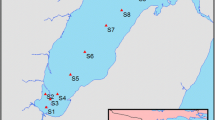Abstract
Turbidity (TB), an important factor that determines water quality, can influence the water supply of reservoirs. Using a submerged optical sensor, the TB of a body of water can be observed. This study aims to use remote sensing (RS) technology in order to examine TB variations of the water in reservoirs. In general, previous studies have focused on evaluating the relationships among a number of single-spectrum bands and in situ data. In this study, we included the Normalized Difference Vegetation Index (NDVI) among the TB monitoring methods for reservoirs and investigated its practical utility. The ratio of NDVI is between −1 and 1. A negative value indicates water or snow; a value of 0 indicates rock or bare soil; and a positive value indicates a vegetative cover. We consider the value of NDVI to be close to −1 in clean water and close to 0 in turbid water. TB, which is the scattering degree of incident light into water, is observed using a submerged optical sensor. Water appears turbid if floating material or suspended solids are found. Therefore, we use NDVI in this study in an attempt to estimate TB concentration. Images from the Landsat-7 ETM+ satellite were used to observe several important reservoirs in northern Taiwan, and multiple linear regression (MLR) was used for analysis. This study examines the data of 47 samples and found the gaps between the 3 days of the in situ date and the date the images were taken. We found that the NDVI has a negative correlation with TB. After including the NDVI in our model, its explaining ability and improvement rate increased by 11.2 and 8.72 %, respectively. Therefore, using the NDVI can provide additional reflective information, as well as improve the model’s accuracy.




Similar content being viewed by others
References
Chang, T. Y., Wang, Y. C., Feng, C. C., Ziegler, A. D., Giambelluca, T. W., & Liou, Y. A. (2012). Estimation of root zone soil moisture using apparent thermal inertia with MODIS imagery over a Tropical Catchment in Northern Thailand. IEEE Trans Geoscience Remote Sensing, 5, 752–761.
Changliang, Y. (2013). A weighted algorithm for estimating chlorophyll-a concentration from turbid waters. Journal of the Indian Society of Remote Sensing, 41(4), 957–967.
Dhillon, J. K., & Mishra, A. K. (2013). Estimation of trophic state index of Sukhna Lake using remote sensing and GIS. Journal of the Indian Society of Remote Sensing, 42(2), 469–474.
Dogliotti, A. I., Ruddick, K. G., Nechad, B., Doxaran, D., & Knaeps, E. (2015). A single algorithm to retrieve turbidity from remotely-sensed data in all coastal and estuarine waters. Remote Sensing of Environment, 156, 157–168.
Garaba, S.P., Badewien, T.H., Braun, A., Schulz, A.-C. & Zielinski, O. (2014) Using ocean colour remote sensing products to estimate turbidity at the Wadden Sea time series station Spiekeroog. Journal of the European Optical Society-Rapid Publications, 9, 1–6, 14020.
He, W. Q., Chen, S., Liu, X. H., & Chen, J. N. (2008). Water quality monitoring in slightly-polluted inland water body through remote sensing - case study of the Guanting Reservoir in Beijing, China. Environmental Science & Engineering in China, 2(2), 163–171.
Koponen, S., Pulliainen, J., Kallio, K., Vepsalainen, J., & Hallikainen, M. (2001). Use of MODIS data for monitoring turbidity in Finnish Lakes. IEEE, 5, 2184–2186.
Liou, Y.-A., Sha, H.-C., Chen, T.-M., Wang, T.-S., Li, Y.-T., Lai, Y.-C., & Chiang, M.-H. (2012). Assessment of disaster lossed in rice paddy field and yield after tsunami induced by the 2011 great East Japan Earthquake. Journal of Marine Science and Technology (JMST), 20(6), 618–623.
Liou, Y.-A., Wang, T.-S. & Chan, H.-P. (2013). Impacts of pond change on the regional sustainability of water resources in Taoyuan, Taiwan, Advances in Meteorology, Article ID 243456, 6. doi:10.1155/2013/243456.
Liou, Y.-A., Liu, H.-L., Wang, T.-S. & Chou, C.-H. (2015). Vanishing irrigation ponds and regional water resources in Taoyuan, Taiwan. Terrestrial, Atmospheric and Oceanic Sciences (TAO), 26(2), Part II, 161–168.
The official website of U.S. Geological Survey (USGS) Landsat project SLC-off products background. (2007). http://landsat7.usgs.gov/data_products/slc_off_data_products/slc_off_background.php.
Wang, T.S., (2010). Application of various-scale satellite images to inland water quality monitoring in Taiwan. Ph.D. Thesis, Department of Civil Engineering and Engineering Informatics, Chung Hua University, 292 pp. (in Chinese).
Wu, G., Leeuw, J. D., Skidmore, A. K., Prins, H. H. T., & Liu, Y. (2007). Concurrent monitoring of vessels and water turbidity enhances the strength of evidence in remotely sensed dredging impact assessment. Water Research, 41, 3271–3280.
Zhang, Y., Pulliainen, J. T., Koponen, S. S., & Hallikainen, M. T. (2003). Water quality retrievals from combined Landsat TM data and ERS-2 SAR data in the Gulf of Finland. IEEE, 41(3), 622–629.
Author information
Authors and Affiliations
Corresponding author
About this article
Cite this article
Chien, WH., Wang, TS., Yeh, HC. et al. Study of NDVI Application on Turbidity in Reservoirs. J Indian Soc Remote Sens 44, 829–836 (2016). https://doi.org/10.1007/s12524-015-0533-6
Received:
Accepted:
Published:
Issue Date:
DOI: https://doi.org/10.1007/s12524-015-0533-6




